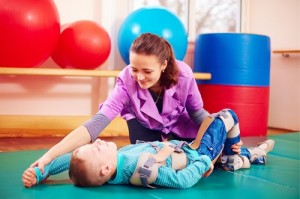Supporting Children with Spasticity
By Sarah Jernigan, MD, MPH, Carolina Neurosurgery & Spine Associates
 When you hear the word “spasticity,” what do you think of? Many people think of the term “spastic” used for years to describe people with cerebral palsy (CP). This term was likely inspired by the sometimes jerking and seemingly uncontrolled muscle movements of those who manage CP. Sadly, it can be a colloquial term used to make fun of someone who is uncoordinated or incompetent, but for someone who lives with spasticity every day, the condition is no laughing matter.
When you hear the word “spasticity,” what do you think of? Many people think of the term “spastic” used for years to describe people with cerebral palsy (CP). This term was likely inspired by the sometimes jerking and seemingly uncontrolled muscle movements of those who manage CP. Sadly, it can be a colloquial term used to make fun of someone who is uncoordinated or incompetent, but for someone who lives with spasticity every day, the condition is no laughing matter.
Spasticity is a condition that can greatly impact a child’s ability to walk and perform other day-to-day activities, and it’s surprisingly common. Two out of every 1,000 children in the United States are born with CP, and 75 percent of those children have spasticity. It can also impact children who have multiple sclerosis or have experienced traumatic brain injury, stroke or spinal cord trauma.
People who live with spasticity describe spasticity as a range of feelings, from a mild sensation of tightness to severe, painful spasms. To understand what spasticity looks like, think of a child living with CP who is sitting with her legs crossed. Her leg might suddenly kick out or jerk forward. This child might be perfectly aware the kick is going to happen, but she may not have the muscle control to prevent it or control her leg.
It’s important to note that spasticity is caused by a dysfunctional signal that loops between the brain, spinal cord and nerves in the arms and legs. Spasticity is not a sign of decreased intelligence or cognitive function.
Spasticity can greatly limit mobility and generate significant discomfort. Although many children (almost 50 percent) with cerebral palsy can walk with the assistance of braces, canes or walkers, spasticity can eventually rob them of that ability.
Spasticity can also negatively impact other parts of the body, including the tendons and ligaments. These changes can cause muscle stiffness, atrophy (deterioration or wasting of the muscle) and fibrosis (changes in the properties of the muscle fibers). Muscles affected by spasticity have difficulty stretching the proper length needed to keep up with a child’s bone growth. The muscle then becomes shorter than it should be and prevents a joint from achieving normal, full range of movement. This condition is known a contracture, and can lead to significant pain and bone deformities.
So what can we do to help children living with spasticity to live their best life?
The initial evaluation for spasticity includes a comprehensive assessment of the presence, severity and impact of spasticity on the child. Physical and occupational therapists evaluate which muscles are affected and start by stretching these muscles. A physiatrist may also prescribe muscle relaxants to help block the abnormal nervous system signals. If these treatments are not effective, Botox injections into specific muscle groups may also help loosen these muscles and stop the cycle of spasticity.
Surgery may be an option in children with more severe spasticity or for patients who do not respond to these other treatments. Two surgical treatment options for spasticity include implantation of an intrathecal baclofen pump and selective dorsal rhizotomy.
Baclofen is a medication used with spasticity treatment. It is a central nervous system depressant and skeletal muscle relaxant. A pump can be implanted into the spinal fluid space and provide baclofen directly to areas of the spinal cord where it is most needed to loosen muscles and prevent spasms. This is appealing because the pump can be removed leaving no lasting or permanent effects.
Selective dorsal rhizotomy is a surgical procedure in which a neurosurgeon permanently cuts the nerves that are firing abnormally and contributing to spasticity. Those nerves are then partially or completely cut, to stop the dysfunctional signal loop, and decrease the spasticity. While the results of this surgery are permanent, these patients must continue with additional spasticity therapies throughout their lifetime.
Taking care of children with cerebral palsy and spasticity requires a team approach from families, therapists, physicians and you. Taking the time to understand spasticity is a great way to be a supportive friend, classmate or neighbor, and can help everyone reach their maximum potential.
Sarah Jernigan, MD, MPH, is a fellowship-trained pediatric neurosurgeon with Carolina Neurosurgery & Spine Associates, home to the largest team of pediatric neurosurgeons in the Southeast. Dr. Jernigan specializes in diagnosing and treating children with brain tumors, hydrocephalus, spasticity, craniosynostosis, spina bifida and vascular disorders such as Moyamoya disease.
This blog was produced in partnership with Charlotte Parent. Click here for the original post and other parenting resources.













